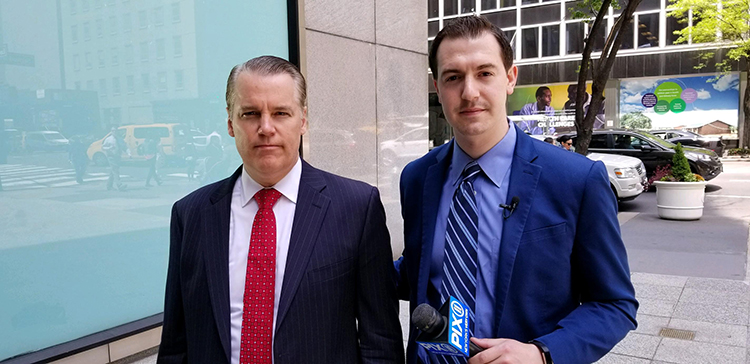Written by Brian E. Reilly, CPP, PSP
CL360 Founder & Managing Director
Recently, I was interviewed by PIX Channel 11’s Henry Rosoff concerning security drills in schools, especially active shooter and lockdown drills; the crux of his piece was whether certain schools in New Jersey were conducting an adequate number of these drills, according to established best practices.
During our discussion, the following question arose: Are active shooter drills more important than fire drills? The answer to that question is a resounding YES! Not to diminish the importance of fire safety, but does anyone recall a single school fire in recent history that resulted in a fatality? Me neither. Can we say the same thing about active shooter events in schools? Tragically, no.
A recent piece from the Washington Post reported that 2018 has been deadlier for school children than deployed service members.
PIX’s investigation revealed that most schools in New Jersey conduct one security-related drill each month, including specific scenarios like active shooter, non-fire evacuation, bomb threat and lockdown, and that at least one drill each year involves local law enforcement. I believe this is a good approach, if each exercise has a genuine after-action review to identify any gaps or deficiencies that surface during it.
EMERGENCY EXERCISE PROGRAM
An effective emergency exercise program is also based on a building block approach – you must crawl before you can walk. An effective program should:
- begin with relevant seminars to train staff and students
- advance to table-top exercises for staff
- proceed to drills for individual scenarios
- culminate in realistic, full-scale exercises involving first responders and all stakeholders.
- lessons learned can be applied to improvement planning, and the revision of emergency plans if appropriate
When it comes to intentional mass casualty events, the name of the game is to improve survivability.
PREPAREDNESS & RESPONSE
Prevention of these types of incidents and target hardening are topics for another time, but let’s touch upon a few key points related to preparedness & response – measures that can mitigate the consequences of such an occurrence, should it not be averted. Let’s cut to the chase scene – when it comes to intentional mass casualty events, the name of the game is to improve survivability; we’ll stick to the active shooter scenario, essentially a homicide in progress involving firearms and/or explosive devices.
How is this accomplished?
1) Individual response measures
There are varying terms one might hear concerning the three-phase approach to surviving an active shooter; among the more common schools of thought are
RUN / HIDE / FIGHT
AVOID / BARRICADE / CONFRONT
AVOID / DENY / DEFEND
RUN / AVOID
- There are some slight differences among the three, but they all advocate getting away from or avoiding the attacker(s) immediately – whether it’s by running away, evacuating the building, or hiding in a room or some other place where you’re out of sight. Ideally, the hiding place has a barrier that will afford a modicum of ballistic protection.
HIDE / BARRICADE / DENY
- Once in the hiding place, measures should be put in place that will prevent the attacker from breaching the threshold, or at the very least significantly delay entry. So, in addition to locking the door (if applicable), and to the extent possible, large items such as desks and filing cabinets, etc. should be placed or stacked in front of the entryway to strengthen the barricade. Again, this is to buy time.
FIGHT / CONFRONT / DEFEND
- The third phase deals with physical aggression toward the adversary; this might take place as a last resort, or at an earlier opportunity depending on the situation. Tactics may include: throwing objects at the shooter to distract them (it’s somewhat harder to concentrate on aiming and shooting a weapon when you’re being bombarded with objects such as a tape dispenser); literally “bum rushing” the assailant and attacking them about the face and body (with or without an improvised weapon); grabbing the weapon in an attempt to keep the muzzle pointed in a less lethal direction or prevent it from being fired, or to take it away completely.
Everything is on the table when you’re about to be murdered! Don’t give up, even if you’re shot – many gunshot wounds are survivable.
2) Building response protocols, such as Lockdown, Lockout, Evacuate & Shelter
Most active shooter drills test Lockdown capabilities, where the shooter is inside the building. In this case – assuming evacuation is not a better alternative – students and teachers retreat to, or remain in a classroom, or other suitable room.
- Doors are LOCKED (a locked door is a great time barrier.)
- LIGHTS are turned off.
- All persons get out of SIGHT, and generally remain still. Hence the expression,
Locks. Lights. Out of Sight.
- If the classroom door has a window permitting visual access into the room, persons should retreat into a pre-identified safety triangle. This is a hard corner where people are not visible to someone looking through the door’s window from the hallway. Many schools identify this zone with tape lining the floor.
- All electronic devices should be silenced (although recording the event may be an option, safety permitting).
- Some capable adults or adolescents should be prepared to confront the assailant by the door, in the event the assailant breaches the door (without standing directly in front of the it.)
3) Law Enforcement response that is well-planned and executed
Pre-planning is key.
- Local law enforcement should be roughly familiar with the layout of the building and have floor plans to the school well in advance.
- They should also be familiar with that school’s building response protocols and be enabled to access the school’s video surveillance system in emergency situations. The faster law enforcement can make entry and identify the location of the attacker, the sooner the attacker will be neutralized.
- Patrol officers should have breaching tools for forcible entry.
4) Hemorrhage control implemented by courageous laypersons at the point of wounding
Naturally, the first priority is to stop the killing (i.e., law enforcement neutralizing the attacker[s].) The next priority is to stop the dying.
STOP THE KILLING / STOP THE DYING
In the aftermath of the shooting, there may be persons who have sustained immediately lethal wounds; there are also those who may have sustained minor wounds. Triage 101 would indicate that these types of patients are not the priority – attention must turn to those critically injured patients that need saving.
Those bystanders present at the point and time of wounding are generally in the best position to address the initial hemorrhage control needs of the wounded. In fact, increasing public resilience to these types of incidents has become a priority for national preparedness, namely, empowering the public to provide appropriate casualty care (bleeding control) through education and strategic placement of medical equipment. There is a growing consensus among experts that bleeding control is the responsibility of the public, and well within their capabilities. See Hartford Consensus. See DHS Stop the Bleed Campaign.
Rapid extrication of the wounded to safety is also key; casualties are no longer expected to remain untreated for significant periods of time. Many experts advocate that the goal is to decrease the time between the first gunshot and the last ambulance door closing.
The goal is to decrease the time between the first gunshot and the last ambulance door closing.
The concepts mentioned here are by no means a cure-all, but are a decent start point in addressing and mitigating the effects of such a tragic occurrence. Hopefully, the leadership of your child’s school emphasizes improving survivability in their response plans.
I’ll conclude by asking the question again – is your child’s school prepared for an active shooter event?
Watch the PIX Channel 11 News interview with Henry Rosoff (transcript included)
Contact CommandLogic 360 to learn more about training for schools. Whether you are an institution or an individual, we are here to discuss how to make your school safer.
Brian E. Reilly, CPP, PSP is the Founder and Managing Director of CommandLogic 360, Inc. Life-long resident of New York, he served in law enforcement with the New York City Police Department for over 22 years – attaining the rank of captain prior to retirement in 2013. In addition to performing uniformed patrol, he worked in a variety of other assignments including policy & planning, investigations, training, and counter-terrorism & emergency management.
His last position in the NYPD was Counter-terrorism Coordinator for the New York City public schools system, overseeing counter-terrorism and emergency management measures for approximately 1400 schools citywide. During his tenure, Brian collaborated with Louis Rapoli in implementing a number of effective programs, including the establishment of tactical protocols for NYPD personnel responding to school attacks (e.g., Columbine, Sandy Hook, etc.) These protocols are comprised primarily of firearms tactics for neutralizing the armed attacker; medical treatment to address the critically wounded in the attack; and overall critical incident management. He further collaborated with Louis and the New York City Department of Education in launching enhanced building response protocols for the city’s school system; these protocols involve actions that school personnel and students take during various types of emergencies.
Since his departure from the NYPD, he has performed consulting work in an array of areas including medical preparedness, emergency management, school safety and crime prevention. He founded CommandLogic 360, Inc. in 2014, and built a team of experts to bring the company’s vision to fruition.
Brian is a volunteer firefighter in his home town in Nassau County, NY; he was also an EMS captain for Riverhead Volunteer Ambulance Corps, and is credentialed in numerous areas related to rescue and trauma care. He holds a Bachelor of Science degree in Business Administration from Saint Joseph’s College (Brooklyn, NY), and is a board-certified Physical Security Professional (PSP) through ASIS International.


